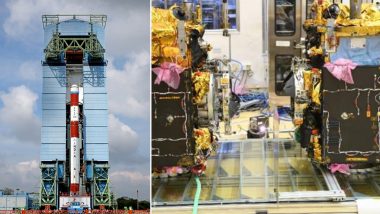Nellore, January 24: The Indian Space Research Organisation (ISRO) today successfully launched the world's lightest satellite ‘Kalamsat’ made by Indian students at 11.40 pm from the First Launch Pad (FLP) of Satish Dhawan Space Centre, Sriharikota. The communication satellite, KalamSat, is designed and built by students who work with a private organisation called "Space Kidz India." Along with Kalamsat, the ISRO also launched Microsat-R, an imaging satellite, by the same launching vehicle. Both the satellites were launched by Polar Satellite Launch Vehicle (PSLV) in its 46th flight.
The ISRO has not charged a single rupee for the launch of Kalamsat. Speaking on the launch, ISRO Chief K Sivan said, "ISRO is open to all students of India. Bring to us your satellites and we will launch it for you. Let's make India into a science-fairing nation."
ISRO Chief K Sivan on successful launch of #PSLVC44 mission, carrying Kalamsat, a satellite made by students: ISRO is open to all students of India. Bring to us your satellites and we will launch it for you. Let's make India into a science-fairing nation. pic.twitter.com/rO9ate1xm3
— ANI (@ANI) January 24, 2019
The Kalamsat satellite weighs just 1.26 kilogram and is lighter than a laptop. It cost Rs 12 lakh to make this satellite, and it was ready in only six days, but the group took six years to perfect the satellite. The satellite is named after Former President Dr APJ Abdul Kalam as a tribute to him. Notably, Kalamsat is the first satellite designed by an Indian Private entity to be launched by ISRO. In 2017, a 64-gram version of Kalamsat named as "Gulab Jamun" was launched by National Aeronautics and Space Administration (NASA), but it never reached the earth's orbit.
Andhra Pradesh: #ISRO launches #PSLVC44 mission, carrying #Kalamsat and #MicrosatR from Satish Dhawan Space Centre, Sriharikota. pic.twitter.com/yBI7xlKARK
— ANI (@ANI) January 24, 2019
Meanwhile, the other satellite, Microsat-R imaging satellite of the Defence Research and Development Organisation (DRDO) weighs 700-kg. About 14 minutes into the flight the rocket would eject Microsat R at an altitude of about 277km, and it would start functioning at an altitude of 450km in about the 103rd minute after take-off. "To reduce weight and increase the mass, an aluminium tank is being used for the first time in the fourth stage," ISRO Chairman K. Sivan had told IANS earlier. ISRO Successfully Launches India’s Heaviest and Most Powerful Satellite GSAT-11 From French Guiana; All You Need to Know.
PSLV is a four-stage launch vehicle with alternating solid and liquid stages. In its normal configuration, the rocket would have six strap-on motors. The PSLV with two strap-on configuration has been identified for this mission, and the configuration is designated as PSLV-DL. PSLV-C44 is the first mission of PSLV-DL and is a new variant of PSLV. In PSLV-C44, the fourth stage (PS4) of the vehicle will be moved to a higher circular orbit to establish an orbital platform for carrying out experiments.
(The above story first appeared on LatestLY on Jan 24, 2019 11:47 PM IST. For more news and updates on politics, world, sports, entertainment and lifestyle, log on to our website latestly.com).













 Quickly
Quickly




















